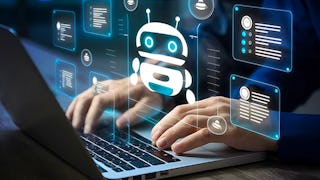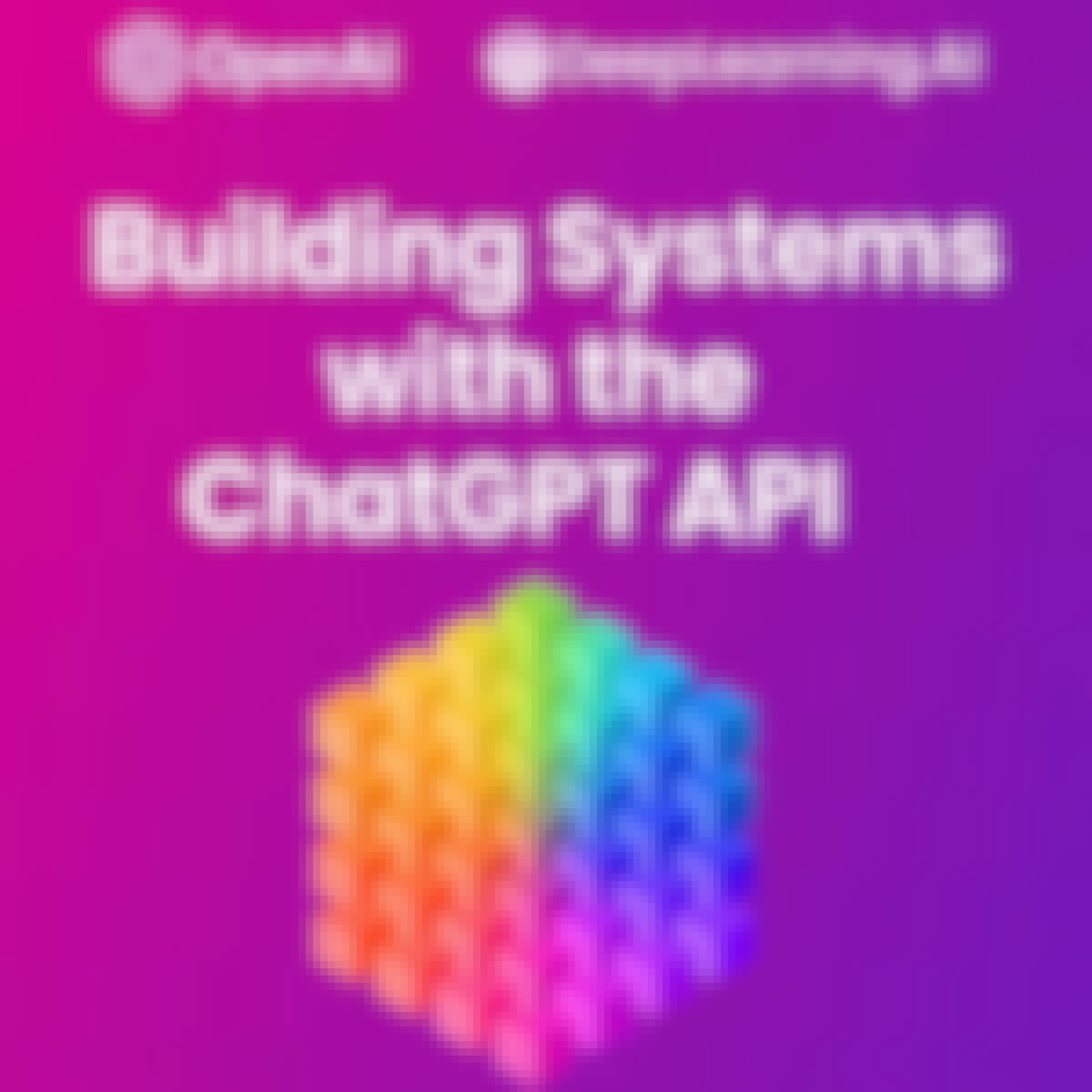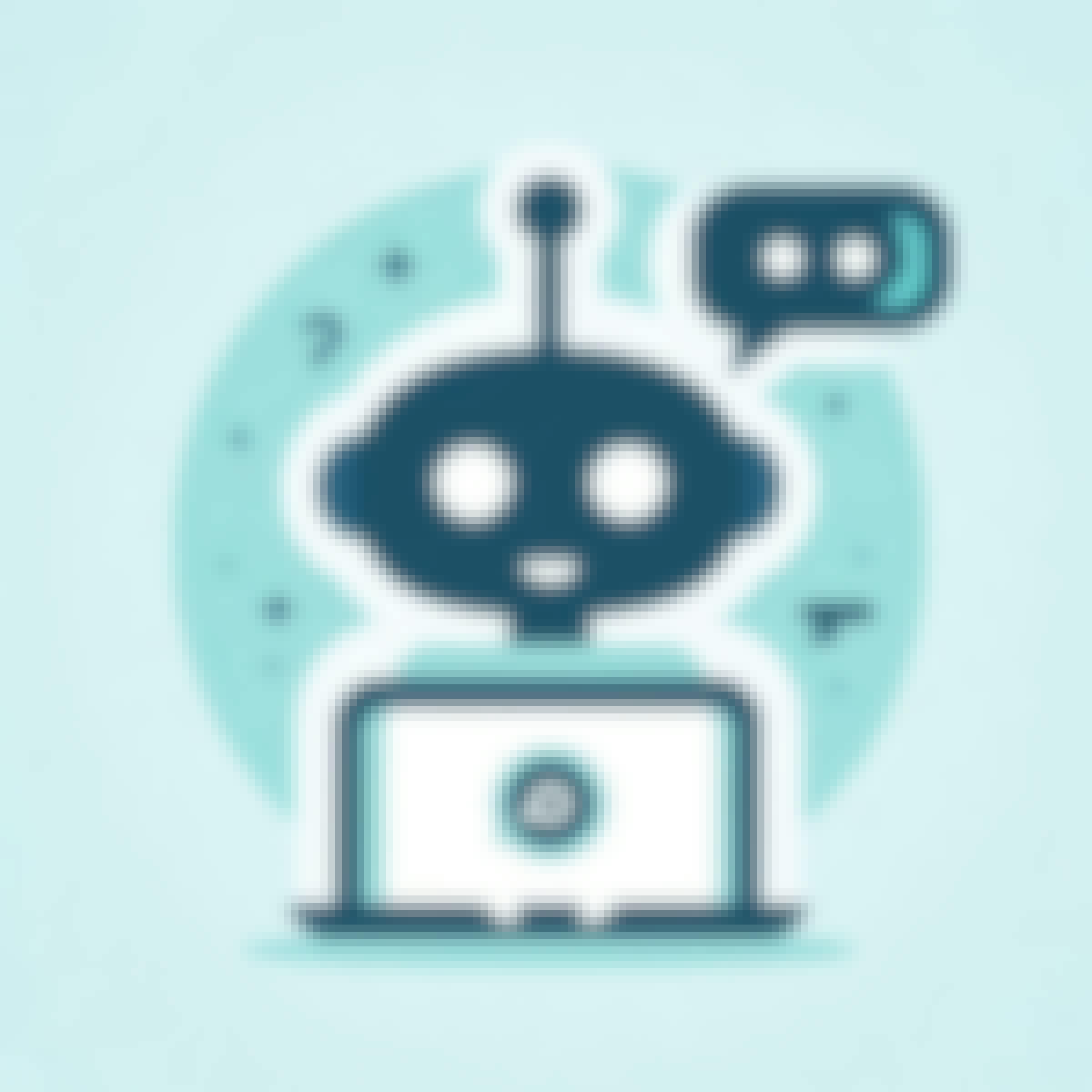- Browse
- Chatbot
Chatbot Courses
Chatbot courses can help you learn natural language processing, dialogue management, and user interaction design. You can build skills in creating conversational flows, integrating APIs, and testing chatbot performance. Many courses introduce tools like Dialogflow, Rasa, and Microsoft Bot Framework, that support developing and deploying chatbots in various applications, from customer service to personal assistants. By engaging with these tools, you’ll gain practical experience in building AI-driven solutions that enhance user experiences.
Popular Chatbot Courses and Certifications
 Status: NewNewStatus: Free TrialFree Trial
Status: NewNewStatus: Free TrialFree TrialSkills you'll gain: Responsible AI, No-Code Development, LLM Application, ChatGPT, Business Metrics, Data Ethics, AI Personalization, Return On Investment, Application Deployment, Artificial Intelligence, AI Product Strategy, Customer experience improvement, Language Interpretation, Translation, and Studies, Performance Measurement, Key Performance Indicators (KPIs), Continuous Improvement Process, Natural Language Processing, Business Ethics, User Feedback, Customer Engagement
Beginner · Course · 1 - 4 Weeks
 Status: Free TrialFree Trial
Status: Free TrialFree TrialSkills you'll gain: Workflow Management, Action Oriented, ChatGPT, No-Code Development, Business Workflow Analysis, Self Service Technologies, Application Deployment, IBM Cloud, Prompt Engineering, LLM Application, Artificial Intelligence, Generative AI, Customer Service, Personalized Service, Operational Efficiency, Customer experience improvement, WordPress
4.7·Rating, 4.7 out of 5 stars3.7K reviewsBeginner · Course · 1 - 3 Months
 Status: NewNewStatus: Free TrialFree Trial
Status: NewNewStatus: Free TrialFree TrialSkills you'll gain: Object Oriented Programming (OOP), Databases, Natural Language Processing, SQL, Data Visualization Software, Python Programming, Matplotlib, Text Mining, Data Processing, Document Management
Mixed · Course · 1 - 3 Months
 Status: Free TrialFree TrialV
Status: Free TrialFree TrialVVanderbilt University
Skills you'll gain: Prompt Engineering, ChatGPT, Prompt Patterns, LLM Application, Productivity, OpenAI, Generative AI, Artificial Intelligence, Large Language Modeling, Artificial Intelligence and Machine Learning (AI/ML), Creative Thinking, Creative Problem-Solving, Problem Solving
4.8·Rating, 4.8 out of 5 stars7.2K reviewsBeginner · Course · 1 - 3 Months
 Status: NewNew
Status: NewNewSkills you'll gain: LangChain, Prompt Engineering, Prompt Patterns, LLM Application, Generative AI Agents, AI Personalization, Front-End Web Development, Application Deployment
Intermediate · Course · 1 - 4 Weeks
 Status: Free TrialFree Trial
Status: Free TrialFree TrialSkills you'll gain: ChatGPT, User Interface (UI), No-Code Development, Self Service Technologies, LLM Application, Customer Support, Generative AI, Artificial Intelligence, Web Content, Quality Assurance
4.4·Rating, 4.4 out of 5 stars12 reviewsBeginner · Course · 1 - 4 Weeks
What brings you to Coursera today?
 Status: FreeFreeD
Status: FreeFreeDDeepLearning.AI
Skills you'll gain: LangChain, LLM Application, Large Language Modeling, Extract, Transform, Load, Data Processing, Data Import/Export, Semantic Web, Generative AI, Prompt Engineering, Document Management
4.8·Rating, 4.8 out of 5 stars653 reviewsBeginner · Project · Less Than 2 Hours

Skills you'll gain: Lead Generation, Email Automation, No-Code Development, Google Sheets, Application Deployment, Real Time Data, Customer Communications Management
4.5·Rating, 4.5 out of 5 stars324 reviewsBeginner · Guided Project · Less Than 2 Hours
 Status: Free TrialFree TrialV
Status: Free TrialFree TrialVVanderbilt University
Skills you'll gain: Generative AI Agents, Prompt Engineering, ChatGPT, Prompt Patterns, Generative AI, Agentic systems, LLM Application, Productivity, Email Automation, AI Personalization, OpenAI, Expense Management, Artificial Intelligence, Personalized Service, Expense Reports, Large Language Modeling, Workflow Management, Responsible AI, Artificial Intelligence and Machine Learning (AI/ML), Automation
4.8·Rating, 4.8 out of 5 stars7.8K reviewsBeginner · Specialization · 3 - 6 Months
 Status: FreeFreeD
Status: FreeFreeDDeepLearning.AI
Skills you'll gain: ChatGPT, LLM Application, Large Language Modeling, Prompt Engineering, OpenAI, Generative AI Agents
4.7·Rating, 4.7 out of 5 stars295 reviewsBeginner · Project · Less Than 2 Hours
 Status: Free TrialFree TrialJ
Status: Free TrialFree TrialJJohns Hopkins University
Skills you'll gain: Collaborative Software, Amazon Web Services, Tensorflow, Applied Machine Learning, LLM Application, Natural Language Processing, Artificial Intelligence and Machine Learning (AI/ML), Application Development, Supervised Learning
Intermediate · Course · 1 - 4 Weeks
 Status: NewNewStatus: Free TrialFree Trial
Status: NewNewStatus: Free TrialFree TrialSkills you'll gain: LangChain, Tool Calling, LLM Application, Agentic systems, Generative AI Agents, Artificial Intelligence and Machine Learning (AI/ML), Application Development, Software Development
4.7·Rating, 4.7 out of 5 stars69 reviewsIntermediate · Course · 1 - 4 Weeks
Searches related to chatbot
In summary, here are 10 of our most popular chatbot courses
- Build and Deploy Chatbots and Recommender Systems: LearnQuest
- Building AI Powered Chatbots Without Programming: IBM
- Python Case Studies: Build Chatbots, Apps & Systems: EDUCBA
- Prompt Engineering for ChatGPT: Vanderbilt University
- Building Smart Chatbots with LangChain: Packt
- Designing a Customer Support Chatbot Using Flowise: Coursera
- LangChain Chat with Your Data: DeepLearning.AI
- Create a Lead Generation Messenger Chatbot using Chatfuel: Coursera
- ChatGPT: Excel at Personal Automation with GPTs, AI & Zapier: Vanderbilt University
- Building Systems with the ChatGPT API: DeepLearning.AI
Frequently Asked Questions about Chatbot
An AI chatbot is a computer program powered by artificial intelligence (AI) that is designed to simulate human conversation and interact with users via text or voice-based interfaces. Chatbots use natural language processing (NLP) and machine learning algorithms to understand user queries and provide automated responses or perform tasks. They can be found in various applications, such as customer support, virtual assistants, information retrieval, and even entertainment.
To excel in AI chatbot development, it's beneficial to develop the following skills:
- Programming: Proficiency in programming languages such as Python, Java, or JavaScript to build the chatbot's underlying logic and functionality.
- Natural Language Processing (NLP): Understanding NLP concepts, including text preprocessing, entity recognition, intent classification, and sentiment analysis, to enable the chatbot to understand and generate human-like responses.
- Machine Learning: Familiarity with machine learning algorithms and frameworks, such as TensorFlow or PyTorch, to train and improve the chatbot's performance over time.
- Dialog Management: Knowledge of conversation flow management and context handling techniques to create engaging and coherent dialogues with users.
- APIs and Integration: Skills in integrating APIs and services, such as language translation, speech recognition, or third-party platforms, to enhance the chatbot's capabilities and access external resources.
- Data Handling: Proficiency in collecting, cleaning, and preprocessing large datasets to train and fine-tune chatbot models.
- Software Development Lifecycle: Understanding of software development practices, version control, testing, and deployment to build scalable and maintainable chatbot applications.
- User Experience (UX) Design: Awareness of UX design principles to create intuitive and user-friendly chatbot interfaces that provide a seamless conversational experience.
- Problem-Solving: Aptitude for analyzing user requirements, identifying challenges, and finding innovative solutions to enhance the chatbot's performance and user satisfaction.
- Communication and Collaboration: Effective communication skills to work in cross-functional teams, collaborate with designers and stakeholders, and gather user feedback for continuous improvement.
With AI chatbot skills, you can pursue various job opportunities, including:
- Chatbot Developer
- Natural Language Processing (NLP) Engineer
- Machine Learning Engineer
- Conversational UX Designer
- Data Scientist
- Virtual Assistant Developer
- Customer Support Automation Specialist
- AI Solution Architect
- Chatbot Analyst
- Research Scientist in NLP or Conversational AI
These roles involve designing, developing, and maintaining AI chatbot applications, improving conversational capabilities, training and fine-tuning chatbot models, and deploying chatbot solutions in various domains.
AI chatbot development is well-suited for individuals who possess the following qualities:
- Strong Analytical and Problem-Solving Skills: The ability to analyze complex problems, break them down into smaller tasks, and find efficient solutions within chatbot development.
- Curiosity and Continuous Learning: A passion for staying updated with the latest advancements in AI, NLP, and chatbot technologies to leverage the best tools and techniques.
- Technical Aptitude: Comfort with programming, algorithms, and software development concepts, allowing for the efficient implementation of chatbot solutions.
- Creativity: An inclination to think outside the box, explore innovative approaches, and design chatbots that provide engaging and personalized experiences.
- Collaboration and Communication: The capacity to work effectively in cross-functional teams, collaborate with UX designers, data scientists, and stakeholders, and effectively communicate technical concepts.
- Attention to Detail: Meticulousness in handling data, refining models, and ensuring accuracy and quality in chatbot interactions.
- User-Centric Mindset: Empathy towards users, understanding their needs, and designing chatbot experiences that provide value and a positive user experience.
- Adaptability: Willingness to adapt to emerging technologies, frameworks, and evolving user expectations to build chatbots that align with current trends and requirements.
Several topics are related to AI chatbots that you can study to enhance your skills and knowledge, including:
- Natural Language Processing (NLP)
- Machine Learning Algorithms and Techniques
- Deep Learning and Neural Networks
- Dialog Management Systems
- Text Generation and Sentiment Analysis
- Speech Recognition and Synthesis
- Conversational UX Design
- Data Collection and Preprocessing for Chatbots
- Reinforcement Learning for Chatbot Training
- Ethical Considerations in AI Chatbot Development
Exploring these topics will provide a comprehensive understanding of AI chatbot development, conversational AI technologies, and the practical aspects of designing, building, and deploying chatbot applications.
Online AI Chatbot courses offer a convenient and flexible way to enhance your knowledge or learn new AI Chatbot skills. Choose from a wide range of AI Chatbot courses offered by top universities and industry leaders tailored to various skill levels.
When looking to enhance your workforce's skills in AI Chatbot, it's crucial to select a course that aligns with their current abilities and learning objectives. Our Skills Dashboard is an invaluable tool for identifying skill gaps and choosing the most appropriate course for effective upskilling. For a comprehensive understanding of how our courses can benefit your employees, explore the enterprise solutions we offer. Discover more about our tailored programs at Coursera for Business here.










